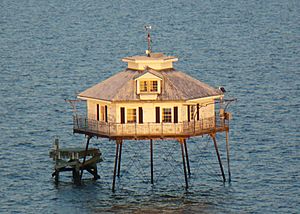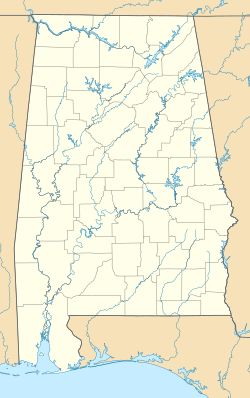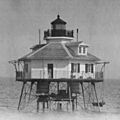Middle Bay Light facts for kids
 |
|
| Middle Bay Light in Mobile Bay, near Mobile, Alabama. | |
|
|
|
| Location | Middle of Mobile Bay, Mobile Bay, Alabama |
|---|---|
| Coordinates | 30°26′17.60″N 88°0′40.48″W / 30.4382222°N 88.0112444°W |
| Year first constructed | 1885 |
| Automated | 1935 |
| Foundation | screw piles |
| Construction | wooden screw-pile lighthouse |
| Tower shape | hexagonal frustum structure with platform, keeper’s quarter and mast with beacon centered on the roof |
| Markings / pattern | white lighthouse |
| Height | 41 feet (12 m) |
| Focal height | 48 feet (15 m) |
| Original lens | Fourth order Fresnel lens, 1885 |
| Current lens | 155 mm solar-powered lens |
| Characteristic | Fl R 6s., bell struck by machinery every 5 seconds. |
| Admiralty number | J3488 |
| ARLHS number | USA-505 |
| USCG number | 4-6490 |
The Middle Bay Light, also known as the Middle Bay Lighthouse, is a special kind of lighthouse. It is shaped like a hexagon and looks like a small house. This lighthouse stands in the middle of Mobile Bay in Mobile, Alabama.
It is called a "screw-pile" lighthouse because it is built on long metal poles. These poles are screwed deep into the muddy bottom of the bay. This design helps the lighthouse stand strong in the water.
Contents
History of Middle Bay Light
The Middle Bay Light began guiding ships in 1885. For many years, a lighthouse keeper and their family lived there. They made sure the light was always working.
Life at the Lighthouse
Life at the lighthouse could be interesting. In 1916, the keeper's wife had a baby right there at the station! The keeper even brought a dairy cow to the lighthouse. He kept the cow on the lower deck so the baby could have milk.
Later that year, a big hurricane hit. Everyone had to leave the lighthouse for safety. Luckily, the lighthouse survived the storm, even though it was damaged.
Changes Over Time
In 1935, the lighthouse became "automated." This means machines took over the job of the keeper. No one needed to live there anymore to operate the light.
The Middle Bay Light is an important historical building. On December 30, 1974, it was added to the National Register of Historic Places. This list includes places that are important to the history of the United States.
In 1984, people worked to make the lighthouse stronger. They wanted to prepare it for its 100th birthday celebration. The original lens, called a Fresnel lens, was later moved. In 1996, the Coast Guard loaned it to the Fort Morgan Museum. You can see it there today.
Restoration and Research
In 2002, efforts began to fix up the lighthouse. People wanted to make sure it stayed in good condition.
In 2003, a special weather station was added to the lighthouse. This station helps scientists learn about Mobile Bay. It measures many things, like rain, sunlight, air temperature, and wind. It also checks water temperature, saltiness, and how much oxygen is in the water. This information helps people understand the bay better. You can even see this data online in real-time!
How the Light Works
When the lighthouse first started, it used whale oil to power its lamp. Lighthouse keepers had to work hard to keep the lamps burning brightly. They also made sure the lens stayed clean so the light could shine far.
Later, the lighthouse used kerosene for fuel. Eventually, the light was changed to run on electricity. Today, the Middle Bay Light uses solar power. This means it gets its energy from the sun!
Images for kids





